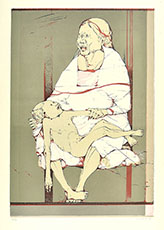Malles Venosta 1919 - Milan 1986
Karl Plattner was born on 13 February 1919 in Mals in the Vinschgau Valley, the last of ten children. He lost his father at the age of four and grew up under the care of his mother. His desire to paint was already evident as a child, when Plattner did paintings for his classmates.
As it was his intention to earn his livelihood in the future by “painting”, he was apprenticed to a housepainter in the village immediately after finishing compulsory schooling, where he learned the trade so well that he had the courage to move to a larger painting business in Brixen. Here in Brixen, he began to paint in his spare time. In 1938 he got to know Anton Sebastian Fasal (1899-1943), a professor at the Academy in Vienna, and this led to him beginning his studies at the Academy, though the war interrupted these until 1945.
In 1945 Plattner was free to do what he wanted and decided to make up for lost time by studying. He enrolled first at the Academy in Florence as an “extraordinary auditing student”, i.e. one who attends lectures but does not take any exams; then, encouraged by his professor, at the Academy of Brera in Milan. Driven by his desire to catch up, he moved to Paris in 1949. There he attended the free Académie de la Grande Chaumière and André Lhote’s (1885-1962) private school.
In 1949 and 1950 Plattner studied and worked in Milan and Florence. During these years he was commissioned to produce his first frescoes in South Tyrol.
In 1950 he moved to France, where he met his future wife Marie Josephe Texier. He created the cartoons for the frescoes of the Monuments to the Fallen in Malles and Naturno, which he completed in 1950-51. According to him, the fresco in Malles is his “first work that left its mark”. The one in Naturno, on the other hand, was marred by negative comments made by the then priest, subsequently badly damaged by vandals, and only regained its dignity in 1968. Plattner fulfilled his wish to leave Europe with his wife in 1952-54 and again in 1956-58, when he lived in Brazil. In the meantime, he won a competition run by the South Tyrol provincial government and was commissioned to depict “productive, economic and cultural activities, or motifs from the South Tyrol landscape” for the front wall of the assembly room of the South Tyrol provincial parliament.
Before his final return from Brazil, Plattner exhibited his works in two exhibitions in Sao Paulo and painted a mural for the newspaper “Folha da Manha”.
His acquaintance with Clemens Holzmeister (1959) marked the beginning of both a professional relationship as well as a long friendship. Plattner was commissioned by Holzmeister to create a panel for the Festspielhaus in Salzburg. This was followed a little later by the Pietà for the church in Alsack. This painting, only very grudgingly accepted by the general public, was felt to be “not sufficiently religious”.
Another relocation ensued, this time to Tourettes sur Loup in the south of France, where he received news of the collapse of the Brazilian bank where he had deposited his money. With limited funds, he moved to Milan, where he exhibited at the Galeria Il Milione.
The frescoes in the Chapel of the Europabrücke followed in 1963-1964. The art critic Raffaele De Grada found them to be “the richest narrative cycle on the history of Europe”. In 1965 he painted the six-part triptych “The Wheel of Life” for the insurance company Austria AG.
After living in Milan for 15 years, Plattner and his wife moved to Paris, where he fell ill and worked in a constant state of isolation. It was only after four years, in 1981, that he decided to mount an exhibition at the Galerie Hervé Odermatt. His next home was Cipières on the Cote d’Azur, interrupted by stays in Paris, Milan and Burgeis.
Karl Plattner died tragically at the age of sixty-seven on 8 December 1986.
Biography from Karl Plattner Archivio
